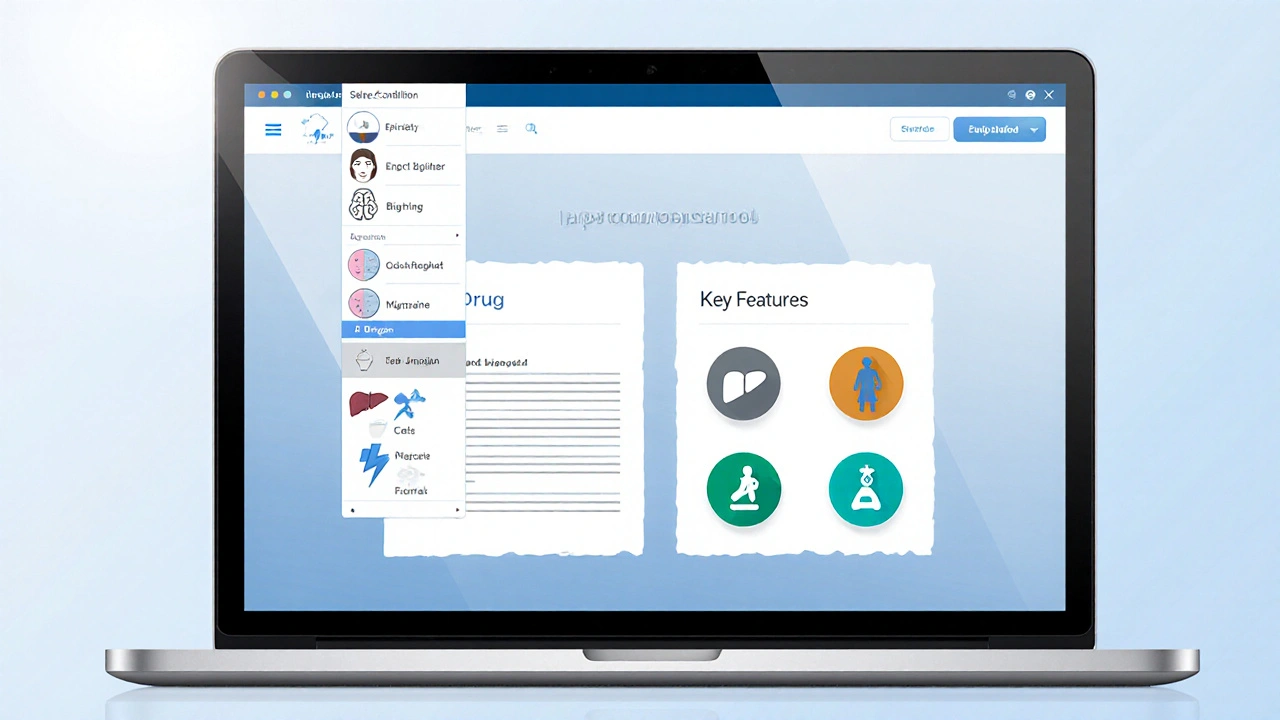Depakote vs Alternatives: Drug Comparison Tool
Drug Profile
Select a drug to see detailed information.
Key Features
- Side Effects
- Pregnancy Risk
- Monitoring
- Cost
Comparison Table
| Drug | Weight Change | Neurologic Side Effects | Pregnancy Risk | Monitoring Needs |
|---|
Key Takeaways
- Depakote is a broad‑spectrum anticonvulsant that also works as a mood stabilizer for bipolar disorder.
- Lamotrigine and carbamazepine are the most common non‑valproate alternatives for seizure control and mood stabilization.
- Pregnancy safety varies widely - valproate (Depakote) carries the highest teratogenic risk, while lamotrigine is considered the safest among the options listed.
- Monitoring requirements differ: Depakote needs regular liver‑function tests and platelet counts; levetiracetam has the lightest lab burden.
- Cost and formulary placement can tip the balance - generic valproic acid is cheap, but newer agents may be covered preferentially by insurance plans.
When doctors, patients, or caregivers hear the name Depakote (Divalproex Sodium), they usually think of a single drug that can treat seizures, bipolar mania, and migraine prevention. The reality is more nuanced. Multiple drugs can address the same conditions, each with its own benefits, drawbacks, and safety profile. This guide lines up Depakote against the most widely used alternatives, breaking down how they work, who they’re best for, and what you’ll need to watch for in daily life.
What Is Depakote (Divalproex) Exactly?
Divalproex is a mixed salt of valproic acid and sodium valproate. It belongs to the anticonvulsant class and doubles as a mood stabilizer. The drug raises the level of gamma‑aminobutyric acid (GABA) in the brain, dampening excessive neuronal firing. FDA approval dates back to the early 1990s for epilepsy, with later extensions for bipolar disorder and migraine prophylaxis.
Why Look at Alternatives?
Even though Depakote is effective, several concerns push patients and clinicians toward other options:
- Pregnancy risk: Valproate is one of the most teratogenic medicines on the market, linked to neural‑tube defects and cognitive impairments in children.
- Side‑effect burden: Weight gain, hair loss, tremor, and rare but serious liver toxicity can make adherence hard.
- Drug interactions: Depakote induces hepatic enzymes, affecting the levels of many other medications.
- Monitoring load: Routine liver‑function tests (LFTs) and complete blood counts (CBCs) add clinic visits.
Choosing an alternative often means trading one set of pros for another. Below we examine the most common substitutes, focusing on the same three clinical arenas: epilepsy, bipolar disorder, and migraine.
Top Alternatives Overview
- Lamotrigine - widely used for bipolar depression and focal seizures.
- Carbamazepine - classic choice for partial seizures and bipolar mania.
- Levetiracetam - favored for its minimal drug interactions and mild side‑effect profile.
- Topiramate - effective for migraine prevention and some seizure types.
- Valproic Acid (generic) - the same active ingredient as Depakote, but usually cheaper.
Side‑Effect Snapshot
Side‑effects shape daily life, so it helps to see them side‑by‑side. Below is a concise view of what patients report most often.
| Drug | Weight Change | Hair/ Skin | Neurologic | Pregnancy Risk (FDA Category) | Monitoring Needed |
|---|---|---|---|---|---|
| Depakote | Weight gain (average +5kg) | Hair thinning, tremor | Drowsiness, dizziness | CategoryX (high teratogenicity) | LFT, CBC every 3months |
| Lamotrigine | Neutral to slight loss | Rash (risk of Stevens‑Johnson) | Headache, blurred vision | CategoryC (moderate risk) | Skin exam during titration |
| Carbamazepine | Neutral | Hyponatremia, rash | Dizziness, ataxia | CategoryD (some risk) | LFT, CBC, sodium levels |
| Levetiracetam | Neutral | None typical | Irritability, mood swings | CategoryC | None routine (optional) |
| Topiramate | Weight loss (average -3kg) | Kidney stones, paresthesia | Cognitive slowing, fatigue | CategoryC | Renal ultrasound if pain |

How the Drugs Compare for Specific Conditions
Epilepsy (Generalized & Focal Seizures)
Depakote is one of the few meds FDA‑approved for both generalized tonic‑clonic seizures and absence seizures. Lamotrigine shines in focal-onset seizures and has a lower interaction burden. Carbamazepine is the go‑to for focal seizures but can worsen certain generalized seizure types. Levetiracetam offers broad coverage with minimal labs, making it popular for newly diagnosed patients. Topiramate works well for refractory focal seizures but may cause cognitive fog.
Bipolar Disorder (Mania & Depression)
Valproate (Depakote) stabilizes mania effectively, comparable to lithium, but its teratogenic profile limits use in women of childbearing age. Lamotrigine is better for bipolar depression prevention and carries the lowest pregnancy risk among mood stabilizers. Carbamazepine can control acute mania but is less effective for depressive phases. Levetiracetam has emerging data for mood stabilization but is not first‑line. Topiramate is not routinely used for bipolar disorder due to limited evidence.
Migraine Prophylaxis
Both Depakote and topiramate have solid evidence for reducing migraine days. Topiramate often wins because it promotes weight loss and has a lower risk of liver toxicity. Valproate is still prescribed when topiramate isn’t tolerated, but its side‑effects and pregnancy warnings keep it lower on the list.
Cost & Insurance Considerations
Generic valproic acid (the active ingredient in Depakote) is usually the cheapest option, often under $10 per month for a typical dose. Lamotrigine’s generic has become more affordable, hovering around $30-$40 monthly. Carbamazepine generics sit near $20. Levetiracetam generics dropped dramatically after patent expiry, now about $25. Topiramate’s price varies widely, with brand versions still pricey.
Formulary placement can shift decisions dramatically. Many U.S. plans place levetiracetam and lamotrigine on tier1, while Depakote remains on a higher tier due to its brand‑name status. Always check the specific plan’s prior‑authorization rules.
Practical Tips for Switching or Starting Therapy
- Consult a neurologist or psychiatrist. They’ll assess seizure type, mood pattern, and reproductive plans.
- Gradual titration. Most alternatives require a slow increase to avoid rash (lamotrigine) or breakthrough seizures.
- Baseline labs. Even for drugs with lighter monitoring, a starting LFT and CBC are good practice.
- Watch for drug‑drug interactions. Carbamazepine induces CYP3A4, lowering levels of many oral contraceptives.
- Pregnancy planning. If you’re planning a family, discuss switching to lamotrigine or levetiracetam early.
When Depakote Still Makes Sense
Despite its drawbacks, Depakote remains a strong choice for patients who need broad seizure coverage and cannot tolerate newer agents. It’s also valuable when rapid mood stabilization is required and other mood stabilizers have failed. In low‑resource settings where generic valproic acid is the only affordable option, clinicians often balance risk with accessibility.
Bottom Line Decision Flow
- If you are a woman of childbearing potential: avoid Depakote unless no alternatives work; consider lamotrigine or levetiracetam.
- If you have focal seizures with mild side‑effects tolerance: carbamazepine or levetiracetam are good first choices.
- If you need both seizure control and mood stabilization, and pregnancy is not a concern: Depakote offers the most coverage.
- If weight gain is a major issue: topiramate (for migraine or seizures) or levetiracetam might be preferable.
- Always check insurance tiers and discuss out‑of‑pocket costs with your pharmacist.
Frequently Asked Questions
Can I take Depakote and lamotrigine together?
Combining the two is generally not advised because both affect mood and seizure thresholds, and the risk of additive side‑effects (especially rash) increases. In rare refractory cases, a specialist may prescribe a low dose of each, but close monitoring is essential.
What lab tests are required for Depakote?
At treatment start, check liver‑function enzymes (AST, ALT) and a complete blood count. Repeat every 3months for the first year, then semi‑annually if stable. More frequent testing is needed if you develop symptoms of liver injury or thrombocytopenia.
Is generic valproic acid as effective as Depakote?
Yes. Generic valproic acid contains the same active ingredient and, when dosed correctly, offers identical seizure control and mood‑stabilizing effects. The main differences are price and pill‑size.
Which alternative has the lowest risk of weight gain?
Levetiracetam is weight‑neutral for most people, and topiramate often leads to modest weight loss. If weight gain is a concern, these two are usually better than Depakote or carbamazepine.
Can I switch from Depakote to lamotrigine without a washout period?
A short overlap (1‑2weeks) is sometimes used, but many clinicians prefer a brief washout to avoid additive toxicity. The exact plan depends on seizure type, dosage, and how well you tolerate each drug.



6 Comments
Kyle Salisbury October 5, 2025 AT 02:18
The comparison does a solid job outlining the major drug differences.
Catherine Mihaljevic October 16, 2025 AT 21:56
Sure the guide looks unbiased but everything pharma pushes is a hidden agenda just trust your gut
Subramaniam Sankaranarayanan October 28, 2025 AT 17:34
First, it is essential to understand that the choice of an anticonvulsant is a complex decision that hinges on pharmacodynamics, pharmacokinetics, and the individual’s comorbid conditions.
Second, the article glosses over the fact that valproate’s mechanism of increasing GABA activity is not uniformly beneficial across seizure subtypes.
Third, the teratogenic risk of Category X drugs is not a footnote; it is a decisive factor that should dominate prescribing patterns for women of childbearing potential.
Fourth, the comparison fails to mention that lamotrigine’s slow titration schedule is a safety feature, not a drawback, because it prevents life‑threatening Stevens‑Johnson syndrome.
Fifth, carbamazepine’s enzyme induction profile dramatically reduces the efficacy of many concomitant medications, a point the table barely hints at.
Sixth, levetiracetam’s minimal drug‑interaction profile is a major advantage in polypharmacy scenarios, especially for elderly patients.
Seventh, the cost analysis overlooks insurance formularies that often place generic valproic acid on a lower tier, yet the hidden costs of monitoring liver function can outweigh the cheap price tag.
Eighth, topiramate’s weight‑loss effect is clinically significant for patients struggling with obesity‑related comorbidities.
Ninth, the article does not address the cognitive side effects of topiramate, which can be debilitating for patients requiring high mental performance.
Tenth, monitoring requirements differ not only in frequency but also in the type of labs; for example, carbamazepine necessitates serum sodium checks to avoid hyponatremia.
Eleventh, patient adherence is heavily influenced by side‑effect profiles, and weight gain associated with valproate is a common cause of discontinuation.
Twelfth, the guide mentions migraine prophylaxis but neglects that topiramate has FDA‑approved migraine indication, whereas valproate is off‑label in many jurisdictions.
Thirteenth, the article’s categorization of “broad‑spectrum” for valproate is misleading because it can exacerbate certain generalized seizures.
Fourteenth, the risk‑benefit calculus must also incorporate quality‑of‑life measures, not just seizure frequency reduction.
Fifteenth, clinicians should employ shared decision‑making tools that incorporate these nuanced differences rather than relying on a simple table.
In summary, while the comparison provides a useful snapshot, it lacks depth in critical safety, efficacy, and patient‑centered considerations.
Callum Smyth November 9, 2025 AT 13:13
Great job breaking down all the options – this really helps when you’re weighing pros and cons! :) Keep the practical tips coming.
Emmons Kimery November 21, 2025 AT 08:51
Thanks for the thorough rundown! 🙌 It’s super useful to see the side‑effect profiles side‑by‑side. 😊
Mimi Saki December 3, 2025 AT 04:29
Loved the clear layout – makes it way easier to figure out what’s best for each condition. 🌟 Keep shining!